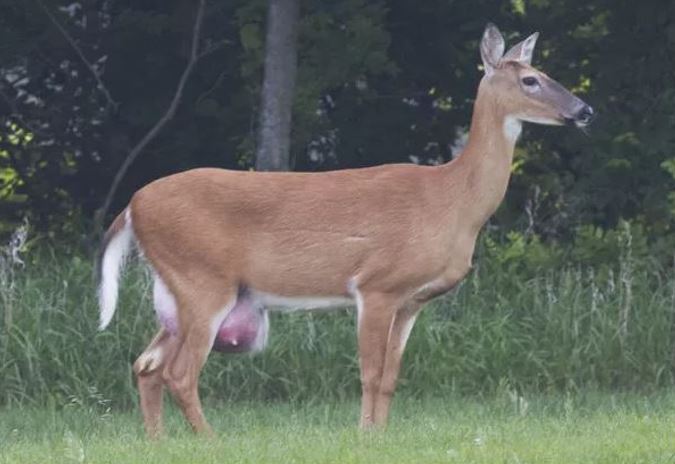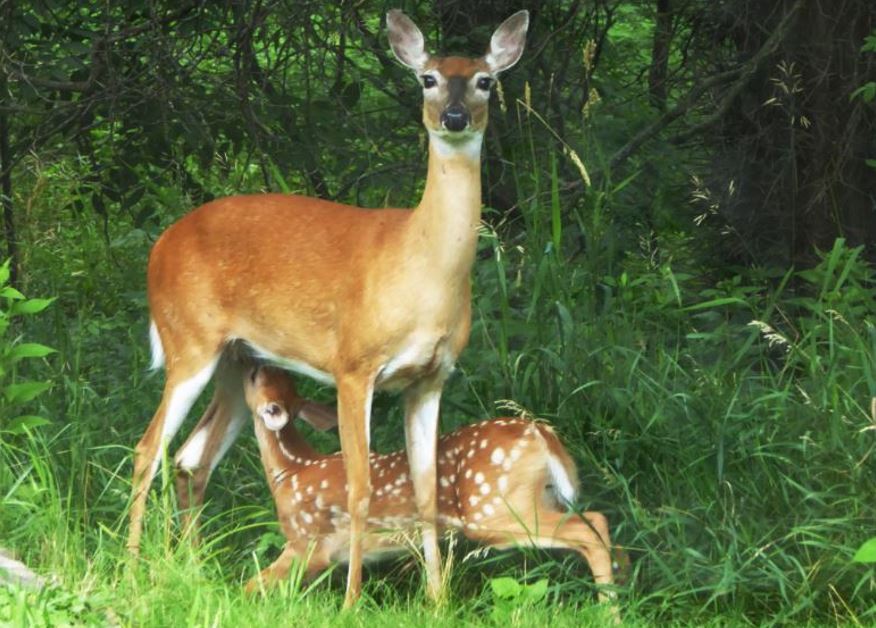An Odd Looking Deer
Question: “I have a whitetail doe with a milk bag the size of a milking goat. She is walking funny and stays off to herself while other deer are feeding in the area. Is this due to perhaps a snake bite or possible a disease?
We have been watching this doe daily for about 2 weeks and the bag appears to have grown larger, but seems to be stable in its current size. No fawn has been seen with this deer. Any idea why this doe has a large udder?”

Response: It’s often difficult to pinpoint what’s wrong with any single deer. Whitetail live in a wild world and are subject to a variety of hazards, both natural and introduced. Although a snake bite is not necessarily a bad guess with regard to the doe in question, a doe with a particularly large udder is more than likely suffering from something else.
Reasons for a Large Udder
In this situation, the whitetail doe is likely dealing with one of four possible issues. Since I don’t have the luxury of looking at a photo of the deer in question, I’m going to toss out four possible things that could be plaguing your deer:
- Abscess
- Tumor
- Hernia
- Mastitis
Deer with Infection or Injury?
1. Abscess – An abscess can occur anytime bacteria enter a deer’s body. When a foreign object enters the body, whether it be a stick, piece of wire, whatever, it brings with in bacteria and infection. The infected, bacteria-ridden area often gets bombarded by the deer’s immune system and confines it to the impacted area. This ares becomes a pus pocket, an abscess. An abscess can be found anywhere in a deer’s body, tissue or organ. Internal abscesses are not often visible unless they are large enough to cause some type of protrusion.
2. Tumor – Like an abscess, a tumor can occur just about anywhere on a deer. Again, the ones we see or suspect must be located just under the deer’s hide causing a protrusion or found externally. External tumors are often black in color. These masses are most often caused by a viral infection and typically range in size from that of a golf ball to a football, with smaller ones more common in size.
3. Hernia – A hernia happens when organs or even internal tissues move into places where they are not supposed to be found. A hernia is the result of a hole, tear in thin muscular wall. A hole in such muscle can occur as a birth defect possible, but is more often the result of trauma. Hernias within a deer can result from fighting, straining during the birthing process, or even from from running into a hard object, such as tree or t-post, for example.
4. Mastitis – Mastitis is caused by a bacterial infection that is specifically confined to a doe’s udder and/or mammary tissues. Mastitis that can lead to inflammation resulting in a noticeably larger udder, milk bag in female deer.
Why a Large Milk Bag?
Of the four potential reasons, the most likely reason for a doe to have a large udder at this time of year is mastitis. Not to say that the deer does not have an abscess or possibly even a hernia, but whitetail does are still actively tending to their fawns during the late summer.

Mastitis occurs when bacteria found on the skin of a deer invades mammary tissue. The most likely time for this to happen is when female deer are lactating and nursing their young of the year. For starters, a doe’s milk bag is larger than normal during this time, which makes it more prone to possible injury outside of nursing. In addition, a fawn can cause injury to a doe during the nursing process by being an aggressive feeders.
Any cut or tear in a teat or the udder creates a possible entry point for bacteria that can lead to mastitis in a deer. The primary question asked was, “Any idea why this doe has a large udder?” I can’t say for sure, but my best guess is the deer has mastitis. After reviewing the possibilities, what do you think?
Dont know, but I have a doe in the same shape as described. Seen herJuly4th and 5th. No fawn with her. Can’t see tits with 10×50’s, color looks normal. My dog had a hernia it had turned black. I know deer are as tough as they come and she doesn’t seem to care. I wonder as the dairy cows next door are always being treated for mastitis?